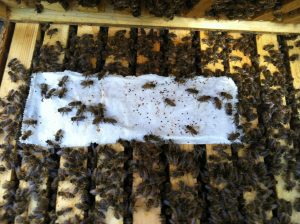Varroa mites are becoming more bothersome. This year we treated in the spring and in the fall after we took our honey off.
Sticky boars have been our monitoring tool of choice. When we used a sticky board to test we had results from 10 to 50+ mites dropped in a twenty four hour period. This method of sampling is nice, neat and easy. But I do see difficulties with it. It only measure the number of mites being dropped. It does not measure those on the bees or, better yet, living in the cells. It is the ones in the cells we need to worry about! It does not seem like this sampling method takes into account any hygienic behavior either. If the bees groom off mites as they come into the hive then a lot will drop, and I would assume that I have a ton of mites in the hive. Instead, in this case, it would indicate the bees doing the hygienic job that we desire. Maybe a better monitoring method is available.
We have treated in the spring and the fall with Formic Acid strips. They actually look and feel more like a patty, but they are referred to as strips. The product is called MAQS by NOD Apiary. This will be the second year we have used this product.
 MAQS may prove to be quite valuable because they claim it is not very hard on the bees and that it can kill mites in the capped brood cells as well as on the bees. The strips smell harsh and the bees quickly move away from it when you get it near them, so I do not know how well it will work, especially in high concentrations in the long run. Monitoring and planning hive ventilation and maximum daily temperatures during the treatment period are key when using this product. So treating all the time with it may be difficult, even though treatment is allowed with the honey supers on.
MAQS may prove to be quite valuable because they claim it is not very hard on the bees and that it can kill mites in the capped brood cells as well as on the bees. The strips smell harsh and the bees quickly move away from it when you get it near them, so I do not know how well it will work, especially in high concentrations in the long run. Monitoring and planning hive ventilation and maximum daily temperatures during the treatment period are key when using this product. So treating all the time with it may be difficult, even though treatment is allowed with the honey supers on.
Our spring treatment showed some mite drop, but the fall drop was enormous. Hopefully it will save some of our colonies from dying from the parasitic mite.